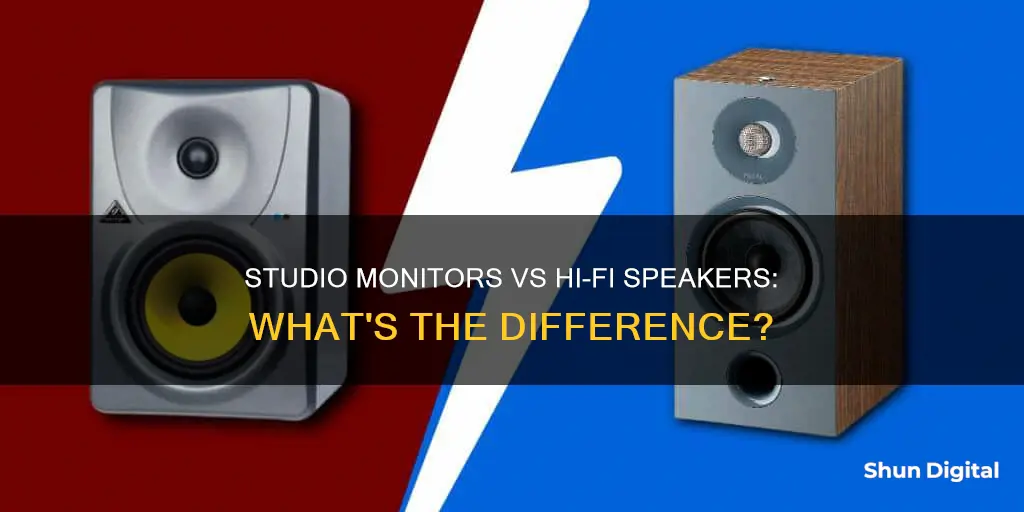
Studio monitors and hi-fi speakers may look similar, but they are designed for different purposes and have distinct characteristics. Studio monitors are used by audio engineers and musicians for critical listening, recording, producing, mixing, and mastering music. They are designed to reproduce audio as close to the original source as possible, allowing users to identify and fix any imperfections. On the other hand, hi-fi or high-fidelity speakers are typically used for home cinema and audio listening, delivering an immersive sound experience with minimal distortion. While studio monitors tend to be active with built-in amplifiers, hi-fi speakers are usually passive and require external power from a separate amplifier. Studio monitors are made for near-field listening, producing a flat and accurate sound, while hi-fi speakers are designed for a wider listening area and often add colour to the audio to enhance the listening experience.
| Characteristics | Values |
|---|---|
| Purpose | Studio monitors are used for recording, producing, mixing and mastering music. Hi-fi speakers are used for home cinema and audio listening. |
| User | Studio monitors are used by audio engineers and musicians. Hi-fi speakers are used by music lovers and audiophiles. |
| Sound | Studio monitors are designed for critical listening and to reproduce audio as close to the original source as possible. Hi-fi speakers are designed to have a full-range frequency response and to reproduce the audio source accurately, or with little to no distortion. |
| Active/passive | Studio monitors are active, meaning they have built-in power amplifiers. Hi-fi speakers are generally passive, meaning they receive power from a dedicated standalone amplifier. |
| Individual power amplifiers | Studio monitors have multiple power amplifiers in one unit, meaning that woofer, midrange and tweeter cones are each powered individually. |
| Crossovers | Studio monitors have crossovers that split frequencies to ensure they go to the right driver. |
| Sound quality | Studio monitors are designed to have a flat, precise sound for nearfield use. Hi-fi speakers are designed to sound good in any environment. |
| Nearfield | Studio monitors are designed for nearfield listening from a specific point. Hi-fi speakers are designed to sound good from any angle in the room. |
| Volume | Studio monitors are not designed to get loud. Hi-fi speakers are designed to fill the entire room with audio. |
What You'll Learn
- Studio monitors are used for analytical hearing to spot flaws, whereas Hi-Fi speakers are designed for the best listening experience
- Studio monitors are used by audio engineers and musicians for recording, producing, mixing, and mastering music. Hi-Fi speakers are used for home cinema and audio listening
- Studio monitors are designed for critical listening, while Hi-Fi speakers are designed to sound good
- Studio monitors are typically active, meaning they have built-in amplifiers. Hi-Fi speakers are usually passive and require an external amplifier
- Studio monitors are designed for near-field listening, meaning they are directed towards a specific location close to the listener. Hi-Fi speakers are designed to sound good from any angle within a room

Studio monitors are used for analytical hearing to spot flaws, whereas Hi-Fi speakers are designed for the best listening experience
Studio monitors and hi-fi speakers may look similar, but they are designed for different purposes and have distinct characteristics. Studio monitors are used for analytical hearing, allowing audio engineers and musicians to spot flaws in the recording, mixing, and mastering processes. On the other hand, hi-fi speakers are designed for the optimal listening experience, focusing on creating an immersive and enjoyable sound for the listener.
Studio monitors are designed for critical listening, enabling audio professionals to identify and fix any issues in the audio. They reproduce audio with extreme precision, aiming for a flat, neutral sound without any colouration or frequency boosts. This means that the audio is reproduced as close to the original source as possible, allowing for the identification of even the smallest details and imperfections. Studio monitors are typically active speakers, with built-in amplifiers, and are designed for near-field listening, meaning they are meant to be heard from a specific, close distance.
Hi-fi speakers, or high-fidelity speakers, are designed for home cinema and audio listening. They aim to reproduce the audio source with high accuracy and minimal distortion, creating an immersive sound experience. Hi-fi speakers usually have a full-range frequency response and are designed to sound good from any angle within a room. They are typically passive speakers, requiring external power from an amplifier.
The key difference lies in the intended use. Studio monitors are tools for audio professionals to create and perfect their recordings, while hi-fi speakers are designed for consumers to enjoy music and movies with the best possible sound quality. Studio monitors provide a flat, precise sound, allowing for critical analysis and the identification of flaws. Hi-fi speakers, on the other hand, enhance the listening experience by adding colour to the sound and ensuring it can be enjoyed from various angles in the room.
While both types of speakers share some similarities, their purposes are distinct. Studio monitors are used for analytical hearing and flaw detection, while hi-fi speakers are designed to provide an immersive and enjoyable listening experience for consumers.
Easy Holter Monitor Application: A Step-by-Step Guide
You may want to see also

Studio monitors are used by audio engineers and musicians for recording, producing, mixing, and mastering music. Hi-Fi speakers are used for home cinema and audio listening
Studio monitors and hi-fi speakers may look similar, but they are designed for different purposes and have distinct characteristics. Studio monitors are used by audio engineers and musicians for recording, producing, mixing, and mastering music. On the other hand, hi-fi speakers are typically used for home cinema and audio listening.
Studio monitors are designed for critical listening, allowing users to identify and fix any audio issues or flaws. They reproduce audio as close to the original source as possible, with no added sound profile or frequency boosts. Studio monitors have a flat, linear frequency response, meaning all audio frequencies are reproduced at the same level. This provides a "blank canvas" for audio engineers to work with and make mix decisions. They are also typically active speakers, with built-in amplifiers, and often have multiple amplifiers to power individual speaker components, resulting in a more accurate and dynamic frequency response.
Hi-fi speakers, or high-fidelity speakers, are designed to deliver an immersive sound experience, reproducing the audio source accurately, with little to no distortion. They are meant to sound good in any environment and from any angle within a room. Hi-fi speakers are typically passive, requiring an external amplifier for power. They usually start with a simple setup of two left and right channel speakers but can be expanded to include subwoofers, floorstanding speakers, and a centre speaker.
While studio monitors are ideal for professional audio production, hi-fi speakers are better suited for consumers seeking an immersive and enjoyable listening experience in their homes. Studio monitors provide a flat and precise sound, making them useful for identifying imperfections in audio recordings. In contrast, hi-fi speakers enhance the listening experience by adding "colour" to the audio, often boosting bass and treble frequencies.
In summary, studio monitors are designed for critical listening and audio production, while hi-fi speakers are designed for an immersive and enjoyable listening experience in home audio and cinema setups.
Asus Monitors: LED-Only or Not?
You may want to see also

Studio monitors are designed for critical listening, while Hi-Fi speakers are designed to sound good
Studio monitors and hi-fi speakers may look similar, but they are designed for different purposes and have distinct characteristics. Studio monitors are designed for critical listening, while hi-fi speakers are designed to sound good.
Studio monitors are used by audio engineers and musicians for recording, producing, mixing, and mastering music. They are designed for analytical hearing, allowing users to identify and fix any flaws in the audio. Studio monitors produce a flat, precise, and neutral sound, reproducing audio as close to the original source as possible. This means that they do not emphasise any particular frequency and do not add any colouration or distortion to the sound. Studio monitors are typically used for near-field listening, meaning they are placed a few feet away from the listener, providing a clear and immediate sound. They are usually active speakers, with built-in amplifiers, and often have multiple amplifiers to power individual speaker components, resulting in a more accurate and dynamic frequency response.
On the other hand, hi-fi speakers, or high-fidelity speakers, are designed for home cinema and audio listening. They aim to provide an immersive sound experience, reproducing the audio source accurately, with little to no distortion. Hi-fi speakers are designed to sound good in any environment and from any angle within a room. They typically have a wider coverage area and higher sound output than studio monitors. Unlike studio monitors, hi-fi speakers are usually passive, requiring external power from an amplifier. While they are designed to reproduce the audio source accurately, they often add some form of colouration to the sound, such as boosted bass and treble frequencies, to enhance the listening experience.
While studio monitors are designed for professional use and critical listening, hi-fi speakers are geared towards consumers and music lovers seeking an immersive and enjoyable listening experience. Studio monitors focus on accuracy and precision, allowing users to identify and fix flaws, while hi-fi speakers prioritise sound quality and immersion, creating a pleasant listening experience.
Removing Stuck Objects from Your Monitor: A Step-by-Step Guide
You may want to see also

Studio monitors are typically active, meaning they have built-in amplifiers. Hi-Fi speakers are usually passive and require an external amplifier
Studio monitors and hi-fi speakers may look similar, but they are designed for different purposes and have distinct features. Studio monitors are typically used in professional settings by audio engineers and musicians for recording, producing, mixing, and mastering music. Hi-fi speakers, on the other hand, are commonly used for home cinema and audio listening.
One of the key differences between the two types of speakers is that studio monitors are usually active, meaning they have built-in amplifiers, while hi-fi speakers are typically passive and require an external amplifier. This distinction is important because it affects the functionality and performance of the speakers.
Studio monitors with built-in amplifiers, or active speakers, have several advantages. Firstly, they can supply power to the woofer and tweeter cones separately, resulting in a more precise sound as these components do not rely on each other for power. Additionally, studio monitors often have multiple amplifiers, dedicated to individual speaker components such as the woofer, tweeter, and mid-range speaker. This feature further enhances the accuracy and dynamics of the frequency response, as each frequency range has its own power source.
However, the built-in amplifiers in studio monitors may not be as powerful as separate, external devices, and they offer less control over the amplification process. In contrast, hi-fi speakers, being passive, require an external power source from an amplifier. This external power source gives users more control over the sound system and audio signals, which is advantageous for home audio setups.
The active/passive distinction also influences the connectivity of the speakers. Studio monitors, being active, can be plugged directly into a mixer or audio interface, while hi-fi speakers, being passive, typically receive power via audio input connections from a central amplifier.
Repairing Studio Monitors: A Step-by-Step Guide
You may want to see also

Studio monitors are designed for near-field listening, meaning they are directed towards a specific location close to the listener. Hi-Fi speakers are designed to sound good from any angle within a room
Studio monitors and hi-fi speakers may look similar, but they are designed for different purposes and have distinct features. Studio monitors are used by audio engineers and musicians for recording, producing, mixing, and mastering music. They are designed for near-field listening, meaning they are directed towards a specific location close to the listener. This allows for a clear, immediate, and precise sound, making it easier to identify and fix any audio issues. On the other hand, hi-fi speakers are typically used for home cinema and audio listening. They are designed to sound good from any angle within a room, providing an immersive sound experience.
Studio monitors are designed for critical listening, reproducing audio as close to the original source as possible. They have a flat, precise, and neutral sound, allowing users to hear all the details of the audio without any added sound profile or frequency boosts. This makes it easier to spot and fix any flaws in the mix. In contrast, hi-fi speakers, or high-fidelity speakers, aim to provide an accurate and immersive sound experience. While they are designed to reproduce the audio source accurately, they often add some form of "colour" to the audio, such as boosted bass and treble frequencies, to make the sound fuller and more pleasing to listeners.
In terms of technical specifications, studio monitors are typically active speakers, meaning they have built-in power amplifiers. They usually have multiple power amplifiers in one unit, with individual power amps for the woofer (bass), midrange, and tweeter (treble) cones, resulting in a more precise sound. Hi-fi speakers, on the other hand, are generally passive speakers, receiving power from a dedicated standalone amplifier. This gives users more control over the sound system and audio signals but requires additional equipment.
The differences in design and functionality between studio monitors and hi-fi speakers make them suitable for different use cases. Studio monitors are ideal for professionals in audio production who need accurate and detailed sound reproduction for critical listening and mixing. Hi-fi speakers, on the other hand, are designed for consumers who want an immersive and enjoyable listening experience in their homes.
Finding Faulty Monitors: Identifying Bad TPS Screens
You may want to see also
Frequently asked questions
Studio monitors are used by audio engineers and musicians for recording, producing, mixing, and mastering music. They are designed for critical listening, meaning they reproduce audio as close to the original source as possible. On the other hand, hi-fi speakers are used for home cinema and audio listening. They are designed to have a full-range frequency response to reproduce the audio source accurately or with little to no distortion.
Studio monitors are designed to have a flat, precise sound for nearfield use, meaning they don't emphasise any one frequency. This allows for critical listening and the ability to pick out sonic imperfections. Hi-fi speakers, on the other hand, are designed to sound good in any environment and with any sound. They often add some sort of "colour" to the audio, such as boosted bass and treble frequencies.
Studio monitors are usually active, meaning they have built-in power amplifiers. Hi-fi and other home speakers are generally passive, receiving power from a dedicated standalone amplifier.
Studio monitors typically have multiple power amplifiers in one unit, with individual power going to the woofer, midrange and tweeter. This results in a more precise sound.
Crossovers split frequencies to ensure they go to the correct driver (speaker). Studio monitors benefit from this by providing added clarity and precision.







